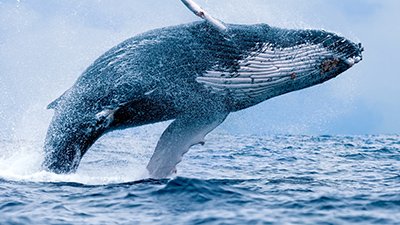How Manatees Lost Their Legs?
A ScienceDaily article1 reported that research published in a recent PNAS article2 gives new evidence as to how manatees may have lost their hindlimbs.
News Sources
Evolutionary theory holds that manatees evolved from land mammals that had hindlimbs. Since these structures would no longer be needed by manatees in the water they were reduced in size and function such that manatees now only possess a small “vestigial” pelvis and no hindlimbs. Both manatees and elephants are believed to share a common ancestor.
Genetics of Pelvic Bone Reduction in Threespine Stickleback (SB) Fish
So if this web article is about manatees, why does it start with a discussion of pelvis reduction in a particular species of fish? The reason is that both threespine SB and manatees are thought to have a reduced pelvis as a result of mutations in the same gene. The authors of the PNAS article claim this is an example of parallel evolution where species that have come from different vertebrate lineages (i.e., the SB fish and manatee share only a very distant common ancestor) use the same process to accomplish the same thing.2
Marine SB and most species of freshwater SB have a complete pelvis.2 Even though it is considered to be vestigial as a result of hindlimb loss, it may actually be an important part of a defense structure against a particular predator.3 A few freshwater species, like the threespine SB, have a complete or partial loss of the pelvis.2 It has been suggested that this could be due to a decrease in the number of predators or a change in the types of predator and that a more streamlined fish may have an advantage in streams and rivers.2,3 This would seem to be a predicted outcome of natural selection. Those that are better adapted to the environment are selected for, live longer, most likely produce more offspring and increase in number within a population.
Further studies with SB have shown that the PitX1 gene plays a role in pelvis formation.3 The protein coding region of PitX1 is the same in all species of SB studied.2,3 However, the expression of the protein in pelvic regions is reduced in threespine SB.3 The difference in the gene among the SB species is thought to occur in an undefined regulatory region.2,3 The changes in the regulatory region of the gene are thought to be quite “young” (10,000–20,000 years ago).2 From a creationist standpoint, this change may have happened as a post-Flood event when rapid speciation occurred as a result of the drastic changes in environment and predator-prey interactions.
Where’s the Evidence?
One of the things that seems strikingly absent in the PNAS paper is the genetic evidence to link pelvis reduction in manatees to SB, which is needed to substantiate the title of the paper, “Parallel Genetic Origins of Pelvic Reduction in Vertebrates” (emphasis added). The ScienceDaily article describes how one of the authors of the PNAS paper came to this conclusion. One day David Kingsley decided to take a break from his normal office routine of reading and writing and go into the lab to do some hands-on research. He decided to weigh the right and left pelvis bones of an acquired manatee collection. He found that the left pelvis bone was typically 10% heavier than the right pelvis bone. This same asymmetry is seen in the threespine SB that he studies. (The asymmetry in the threespine SB is thought to be due to the compensation of the closely related gene PitX2 which is preferentially expressed on the left side during development).3 So he drew the conclusion that maybe the PitX1 gene is responsible for pelvis reduction in threespine SB and manatees, since both have allegedly lost their hindlimbs during evolution. This is a logical conclusion for an evolutionist, and the next step was to examine the PitX1 gene in manatees.
The problem is that he has not examined the PitX1 gene in manatees yet and the data concerning manatee pelvic bones weight asymmetry was published in a paper that mainly discussed examination of the PitX1 gene in ninespine SB fish (which also have an absent or reduced pelvis). So the title of the paper is very misleading since only the genetics of the SB is known. The manatee data appears to have been added to the paper just to give more weight (no pun intended!) to the authors’ ideas about the evolution of hindlimb loss in sea-dwelling creatures. There have been cases where very similar structures in organisms are controlled by completely different genes, such as segmentation and sex determination in insects.4 Further research is needed to provide evidence that SB and manatees use the same genetic mechanism for reduced pelvis size.
Is the Manatee Pelvis Really Vestigial?
If scientists eventually find that the PitX1 gene has reduced expression in pelvic regions in manatees, would that give further support to the theory that the pelvis in manatees is a vestigial remnant of lost hindlimbs? The simple answer is no. The reason is that the pelvis in manatees is most likely not vestigial. Although the manatee pelvic bones are not attached to the skeletal frame, they are near reproductive organs and the bladder.5 In whales, the pelvis is used to support internal organs and serves as an attachment point for muscles—very similarly to the function of the coccyx (tailbone) in humans (also claimed to be vestigial).6 It is highly probable that a similar function is served by the pelvis in manatees. Further research may determine whether the 10% asymmetry is inconsequential or whether it has a function. God may have designed the manatee to produce the level of PitX1 protein necessary to produce a pelvis that would be just the right size to perform the functions of support and attachment. The manatee pelvis is not reduced in size, implying it was once bigger; it’s just the size the Creator intended it to be.
For More Information: Get Answers
Remember, if you see a news story that might merit some attention, let us know about it! (Note: if the story originates from the Associated Press, FOX News, MSNBC, the New York Times, or another major national media outlet, we will most likely have already heard about it.) And thanks to all of our readers who have submitted great news tips to us. If you didn’t catch all the latest News to Know, why not take a look to see what you’ve missed?
(Please note that links will take you directly to the source. Answers in Genesis is not responsible for content on the websites to which we refer. For more information, please see our Privacy Policy.)
Footnotes
- Manatee Bones Lead to New Insight on Evolution, ScienceDaily, August 31, 2006.
- Michael Shapiro, et al., Parallel Genetic Origins of Pelvic Reduction in Vertebrates, Proceedings of the National Academy of Sciences, 103(37):13753–13758. 2006.
- Michael Shapiro, et al., Genetic and Developmental Basis of Evolutionary Pelvic Reduction in Threespine Sticklebacks, Nature, 428:717–723.
- Jonathan Wells, Icons of Evolution (Washington, DC: Regnery Publishing, 2000).
- Manatee Anatomy Facts and Trivia.
- Jerry Bergman and George Howe, “Vestigial Organs” Are Fully Functional, Creation Research Society Books, 1993.
Recommended Resources

Answers in Genesis is an apologetics ministry, dedicated to helping Christians defend their faith and proclaim the good news of Jesus Christ.
- Customer Service 800.778.3390
- © 2025 Answers in Genesis






